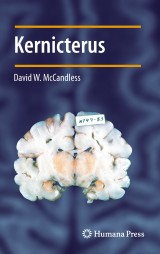Details

Kernicterus
Contemporary Clinical Neuroscience
|
149,79 € |
|
| Verlag: | Humana Press |
| Format: | |
| Veröffentl.: | 02.09.2010 |
| ISBN/EAN: | 9781441965554 |
| Sprache: | englisch |
| Anzahl Seiten: | 286 |
Dieses eBook enthält ein Wasserzeichen.
Beschreibungen
Kernicterus (bilirubin encephalopathy) is a highly interesting example of metabolic encephalopathy. It fills all the characteristics of a metabolic encephalopathy in that it can develop rapidly, produces signature signs and symptoms, and is amenable to successful treatment. In the absence of treatment kernicterus can produce devastating sequelae and death.
The present volume will examine the biochemistry and physiology of bilirubin as well as its hepatic metabolism and renal excretion. Chapters will elaborate bodily disposition of bilirubin and its neuropathology. Both early treatments and current therapy will be discussed in detail. Phototherapy will be presented, and its efficacy and influence on incidence thoroughly examined.
The present volume will examine the biochemistry and physiology of bilirubin as well as its hepatic metabolism and renal excretion. Chapters will elaborate bodily disposition of bilirubin and its neuropathology. Both early treatments and current therapy will be discussed in detail. Phototherapy will be presented, and its efficacy and influence on incidence thoroughly examined.
Dedication page.- Preface.- Acknowledgement.- Key words.-Chapter 1 Prologue: Hyperbilirubinemia, kernicterus, and world health concerns.-Chapter 2 History of bilirubin.-Chapter 3 Biochemistry and physiology of bilirubin.- Chapter 4 Prematurity.- Chapter 5 Erythroblastosis fetalis.- Chapter 6 Gunn rats.- Chapter 7 Crigler-Najjar Syndrome.- Chapter 8 Neuropathology of kernicterus.- Chapter 9 Bilirubin and energy metabolism.- Chapter 10 Bilirubin and other biochemical changes.- Chapter 11 Jaundice and breast milk.- Chapter 12 Jaundice and malaria.- Chapter 13 Jaundice and congenital pyloric stenosis.- Chapter 14 Phototherapy for hyperbilirubinemia.- Chapter 15 Non phototherapy treatment.- Chapter 16 Hyperbilirubinemia revisited.- Chapter 17 Auditory brainstem response.- Chapter 18 Progressive familial intrahepatic cholestasis.- Chapter 19 Kernicterus in older children and adults.- Chapter 20 Cerebral palsy and counseling.- Chapter 21 Neurological sequelae from jaundice.- Chapter 22 Neurobehavioral teratology.- Chapter 23 Gene therapy for hyperbilirubinemia.- Chapter 24 Epilog: Kernicterus: comments and future directions.- Appendix.- References.- Index.
Dr. David W. McCandless is the John J. Sheinin Professor of Anatomy in the Department of Cell Biology and Anatomy at The Chicago Medical School, Rosalind Franklin University, North Chicago, IL, USA. He has over 35 years of laboratory research into basic mechanisms of various metabolic encephalopathies. He serves as Editor-in Chief of the journal Metabolic Brain Disease (Springer), now in its 26th year. Dr. McCandless has been on the faculty or research staff at The University of Vermont College of Medicine, NIH-NINCDS, University of Texas Medical School at Houston, and The Chicago Medical School, and was a visiting professor at Washington University School of Medicine.Dr. McCandless has published in journals such as The J. Clinical Investigation, Nature, Proc. National Academy of Sciences, Amer. J. of Physiology, Brain Research, J. Neurochemistry, Teratology, Epilepsia, Stroke, and many others
<p><i>Kernicterus</i> is an excellent example of a metabolic encephalopathy. It clearly produces a biochemical lesion early when bilirubin first enters the brain. If initial staining can be minimized or reversed, permanent damage can be avoided. This takes strict attention to detail, and a keen ability for timely and accurate diagnosis. The potential for improvement/reversal argues strongly for increased awareness by all health care workers. <br></p><p><i>Kernicterus</i> will examine the history, biochemistry, physiology, neuropathology, etc., of bilirubin. New concepts of how bilirubin is toxic, and damages the acoustic system will be thoroughly examined. The promising new treatment possibility using gene therapy will be examined in detail. This therapy has been successfully used in the excellent animal model, the Gunn rat. Translation of these exciting results to newborn infants is well underway. <br></p><p>About the Author: <br>Dr. David W. McCandless is the John J. Sheinin Professor of Anatomy in the Department of Cell Biology and Anatomy at The Chicago Medical School, Rosalind Franklin University, North Chicago, IL, USA. He has over 35 years of laboratory research into basic mechanisms of various metabolic encephalopathies. He is the Founding Editor of the journal Metabolic Brain Disease (Springer), now in its 27th year. Dr. McCandless has been on the faculty or research staff at The University of Vermont College of Medicine, NIH-NINCDS, University of Texas Medical School at Houston, and The Chicago Medical School, and was a visiting professor at Washington University School of Medicine. Dr. McCandless has published in journals such as The J. Clinical Investigation, Nature, Proc. National Academy of Sciences, Amer. J. of Physiology, Brain Research, J. Neurochemistry, Teratology, Epilepsia, Stroke, and many others.</p>
The book is designed to examine the biochemistry and physiology of bilirubin New concepts relating to the way in which bilirubin is toxic This volume with examine bilirubin's formation, metabolism, transport and excretion in detail Includes supplementary material: sn.pub/extras

















